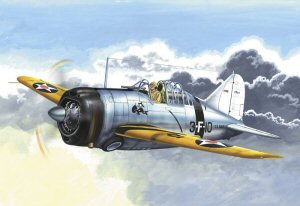
Classic Airframes 1/48 F2A-1 Buffalo Kit First Look
By Michael Benolkin
| Date of Review | June 2005 | Manufacturer | Classic Airframes |
|---|---|---|---|
| Subject | Brewster F2A-1 Buffalo | Scale | 1/48 |
| Kit Number | 4100 | Primary Media | Styrene, Resin, Photo-Etch |
| Pros | Excellent detailing in the cockpit, Eduard color photo-etched parts included! | Cons | |
| Skill Level | Intermediate | MSRP (USD) | Out of Production |
First Look
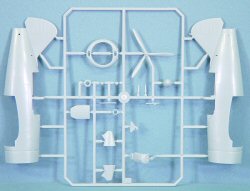 |
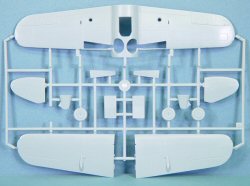 |
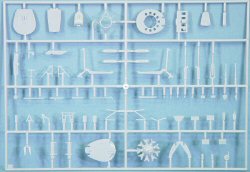 |
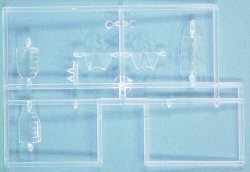 |
 |
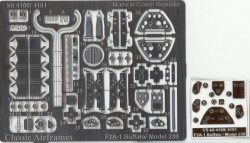 |
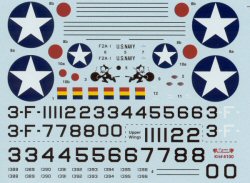 |
Brewster & Company was founded in the early 19th century as a manufacturer of horse-drawn wagons and carriages. In 1920, the Brewster & Company Aircraft Division started out as a vendor to the Naval Aircraft Factory producing aircraft floats. Soon they were also producing sub-assemblies for Chance Vought and Grumman. Nevertheless, the engineers at Brewster wanted to develop an aircraft design of their own.
Brewster's first aircraft opportunity was for a low-wing, all-metal, two-place, torpedo/bomber/reconnaissance aircraft. The design was approved by the US Navy and designated SBA. Production of the SBA was diverted to the Naval Aircraft Factory and the production aircraft were designated SBN-1.
The next opportunity was for a new generation of monoplane fighter that could operate from aircraft carriers, this requirement coming in the late 1930s. Two designs would move forward out of this competition, the Brewster F2A and the Grumman F4F. Brewster succeeded in with their new design that was named 'Buffalo' and orders came in from overseas for this new fighter.
In the hands of the Finnish Air Force, the Buffalo was achieving 3:1 kill ratios against Stalin's fighters, while in the Pacific, the aircraft was faring better than its Japanese counterparts. What sealed the fate of the aircraft was its developer - Brewster. Aggressive marketing resulted in four times the orders than the production capacity of the Brewster factory. Federal directives for overseas deliveries meant that US Navy orders were a low priority in order to get aircraft out to allies in combat. The company was then caught in the middle of an arms scandal arising from the Spanish Civil War. The consequences of all of these woes put the company under government control, its production facilities were used to build sub-assemblies for Grumman and Consolidated, and it was ultimately shut down in 1944.
The full potential of the Buffalo was never realized due to the problems within the company. The US aircrews that would take the Buffalo into action against the Japanese at Midway were not yet combat seasoned, and the veteran Japanese pilots decimated the defending F2As and F4Fs. Nevertheless, proof that the aircraft was capable came out of that same battle. Captain William Humbert, USMC, was attacking a Japanese bomber when his F2A was jumped by Zeros. A 20mm round blew a hole through the fuselage but the aircraft was okay. He dove the aircraft down to the surface of the ocean and used the airspeed gained in the dive to extend away from a single Zero that followed. When Captain Humbert had sufficient lead on the Zero, he reversed the aircraft and flew head-on towards the Zero. He opened fire with his machine guns until he passed the A6M2, then saw the aircraft fly into the ocean. In the right hands and with the right tactics, the Buffalo had held its own as it had in service with Finland, Dutch East Indies, Australia and New Zealand.
Buffalo 101
With the 'old' 1/48 F2A-2 from Tamiya, the 1/48 F2A-1 and Model 239 from Classic Airframes, and the 1/48 F2A-3 from Special Hobby, I thought we'd take a few minutes to look at the differences between these aircraft.
| F2A-1 | F2A-2 | F2A-3 | |
| Spinner | Small spinner ahead of propeller | Large spinner enclosing propeller hub | No spinner |
| Propeller | Hamilton Standard Prop | Cuffed Curtiss-Electric Prop | Cuffed Curtiss-Electric Prop |
| Engine | R1820-22 @ 950 hp | R1820-40 @ 1200 hp | R1820-40 @ 1200 hp |
| Length | 26' 0" | 25' 7" | 26' 4" |
| Wingspan | 35' 0" | 35' 0" | 35' 0" |
| Mods | Cowling shortened by 5 inches; vent removed behind cockpit; ventral window changed; array of dorsal air vents aft of cowling | Nose lengthened by 10 inches between cowl and wing |
For export sales, the Brewster Model 239 was an F2A-1 without the tailhook or ventral window, and used a ring type gunsight. The Model 339 series were variations of the F2A-2, also without the tailhook or ventral window, and used a fixed or reflective gunsight. Some had pneumatic tailwheels, many had fixed (non-retracting) tailwheels. Other subtle differences existed between air forces, so check your references, but this brief run-down gives you a starting point.
Classic Airframes has released a pair of Buffalos, the F2A-1 and the Model 239. In this release, the kit represents the first generation of USN/USMC Buffalo, the F2A-1. The kit is molded in light gray styrene and presented on three parts trees, plus a single tree of clear parts.
In addition, the kit includes a small bag of resin parts, three parts actually, one is the rear of the engine as visible from the main wheel wells, and the other two parts are the internal wing frames that are also visible through the wheel wells.
A fret of photo-etched parts round out this kit that provide some great detailing in the cockpit and underwing bomb racks.
The cockpit captures the look of the open floor that allows the pilot to see through the ventral window. Several canopy options are present on the clear parts, but these options are used on the export versions of the Buffalo.
In addition to the nicely detailed cockpit, the kit also provides a nice looking engine and lots of detailing for the insides of the main wheel wells. You can see all the way up to the machine gun mounts at the top of the fuselage!
I decided to compare the kit with the line drawings found in the Kagero F2A Buffalo book. The outline and shape appear to be spot-on.
Decals are provided for ten (!!) examples:
- F2A-1, BuNo 1393, NAS Norfolk, 1941
- F2A-1, BuNo 1396, 3-F-10, VF-3, USS Saratoga, 1939
- F2A-1, BuNo 1395, 3-F-11, VF-3, USS Saratoga, 1939
- F2A-1, BuNo 1394, 3-F-12, VF-3, USS Saratoga, 1939
- F2A-1, BuNo 1393, 3-F-13, VF-3, USS Saratoga, 1939
- F2A-1, BuNo 1392, 3-F-14, VF-3, USS Saratoga, 1939
- F2A-1, BuNo 1391, 3-F-15, VF-3, USS Saratoga, 1939
- F2A-1, BuNo 1390, 3-F-16, VF-3, USS Saratoga, 1939
- F2A-1, BuNo 1389, 3-F-17, VF-3, USS Saratoga, 1939
- F2A-1, BuNo 1388, 3-F-18, VF-3, USS Saratoga, 1939
The color profiles in the kit are printed in black and white, but full-color profiles were available on the Classic Airframes' website.
The only complaint I have with this kit is packaging. The clear parts were in the same sealed bag as the rest of the kit and several of the sliding canopy options had broken loose. While I didn't see any scratches on the clear parts, my examples had shipped straight from the manufacturer.
This is a beautifully done kit and ought to build as nice as it looks. I certainly hope that there is an F2A-2 and Model 339 on the horizon, as the F2A-3 has also just been released in 1/48 by Special Hobby.
My sincere thanks to Classic Airframes for this review sample!
References:
- Brewster F2A Buffalo, Andre Zbiegniewski, Kagero, 2003, ISBN 83-89088-14-2
- F2A Buffalo in Action, Jim Maas, Squadron/Signal Publications, 1987, ISBN 0-89747-196-2







